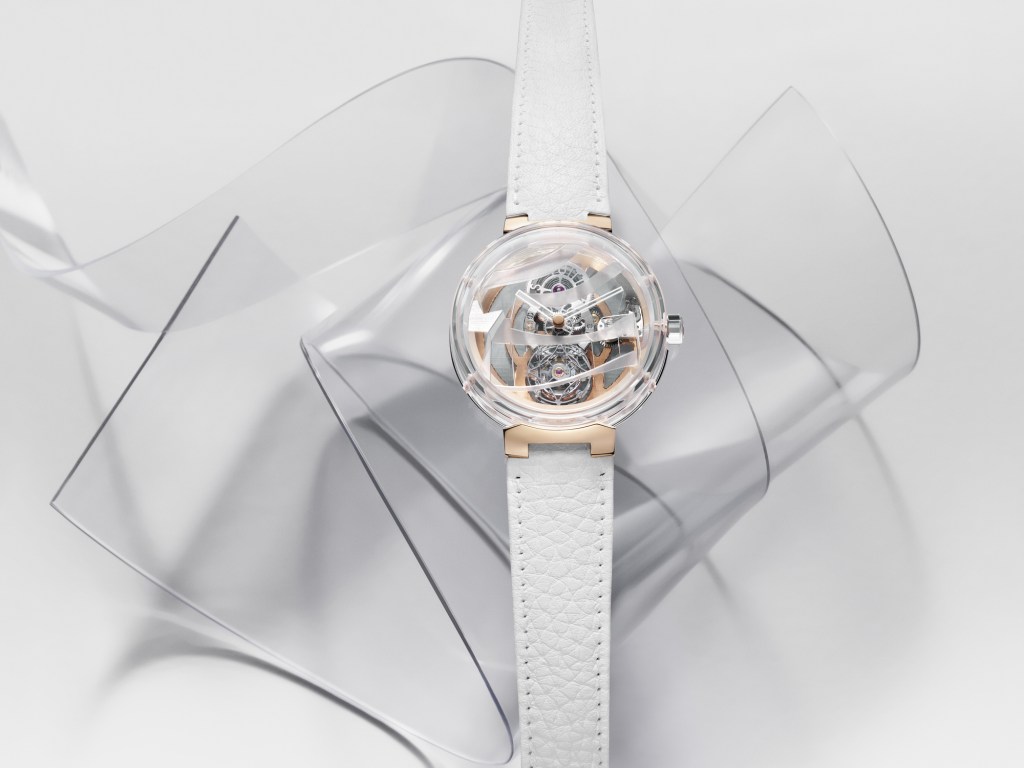PARIS — Louis Vuitton’s latest high watchmaking timepieces, to be revealed Wednesday at an event in Megève, are a manifesto for the rare specialized crafts involved in their creation.
With four collections and a total of seven designs, the wealth of know-how that La Fabrique du Temps and Louis Vuitton’s director of watches Jean Arnault seek to perpetuate is on full display.
Starting with watchmaking itself. “When I started my career, it was considered a manual job,” recalled La Fabrique du Temps master watchmaker Michel Navas. “When I learned it had recently become a métier d’art, it made me glad.”
It is no longer only that. Its artistic aspect is apparent in the Tambour Moon Saphir Tourbillon Volant Poinçon de Genève designed by Frank Gehry.
Fitted with a flying tourbillon developed in-house, it is the first watch with an all-sapphire case and dial to get the prestigious hallmark that indicates a watch was entirely created, developed and assembled in Geneva. The crown, lugs and hands were also cut from sapphire.
For this timepiece, which was two years in the making and measures 48.3 millimeters across, medical tools and binocular microscopes were needed to carve out the dial, which takes its cues from the rippling glass structure that seems to float above the roof of the Gehry-designed Louis Vuitton Maison Seoul.
Another example is the Tambour Slim Vivienne Jumping Hours, on which the zany brand mascot embarks on new adventures in richly detailed white gold gem-set cases. Both designs display the time thanks to two apertures on the dial for the hour and an almost invisible minute hand.
On the Sakura model, she sports a kimono, a parasol and a fan, with cherry blossoms as the marker of passing time. One plays peekaboo between the two-hour apertures, while another is mounted on a transparent hand that makes it seem to float around the dial.
As an astronaut, Vivienne floats in space amid Monogram flower motifs, planets and a spaceship. She wears a hand-painted red and black suit and a comet orbits the dial as minute indicator.

“To create such pieces, we need to have watchmakers like me, but we also need designers, engineers as well as those métiers d’art that we are bringing,” he told WWD. “With Jean [Arnault], we are very sensitive to this so that idea is really to bring within La Fabrique du Temps all these crafts that we need in order to create such pieces — and we are nowhere near done.”
Most recently integrated is guillochage, a vanishing craft that is also key to another brand hosted by La Fabrique du Temps, Daniel Roth.
To address this, the watchmaking hub brought in Marc Ferland, a recently retired master of the craft, and has restored one of the last machines used in the production of this emblematic engraving technique. Two more are under refurbishment, while candidates to become Ferland’s apprentices are being screened.
For the Escale Cabinet of Wonder Métiers d’Art watches, limited to 20 pieces of each design, no less than eight crafts were employed, from champlevé enameling and marquetry to the rare technique of damascening, which yields the distinctive wave-like pattern seen on sabers and high-end steel knives.
Here it is applied to gold to create the watery backdrop of the Dragon’s Cloud version, part of a trio of watches inspired by Gaston-Louis Vuitton’s collection of tsuba, the often-ornate hand guards on Japanese swords.
Best remembered as an erudite inventor, cultural magpie and keen collector, the third-generation scion of the founding family amassed a collection of nearly 1,000 of them.
The blue for the white-gold sculpted carps swimming on the dial of the Koi’s Garden design was obtained through kiln-firing to obtain a dark oxide layer that accentuates the three-dimensional sculptures. In all, the dial took 150 hours to complete.
Stone-cutting was used on all three watches, most visibly in the Art Deco-style initials GLV, in honor of the Vuitton scion.

Enameling and its many techniques are already among the crafts integrated into La Fabrique du Temps.
One example: the Voyager Flying Tourbillon Poinçon de Genève Plique-à-jour and its delicately translucent shades of blue that evoke stained glass windows, which calls on a technique that was invented in the fifth century by Byzantine artisans.
Enamel is deposited on open cells instead of being applied to a surface, calling for nimble and light movements to ensure an even spread without air pockets. Most complex of all is the circular subdial at 12 o’clock, with its gradient of blues.
But don’t think La Fabrique du Temps is only about stewarding the past. “We are a bit like a think tank,” said Navas. “Of course, we are watchmakers and we respect our DNA because it’s our craft but we are looking forward to displaying things in a different way.”



